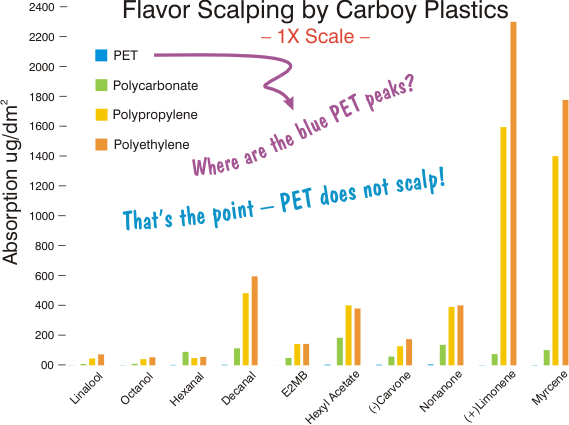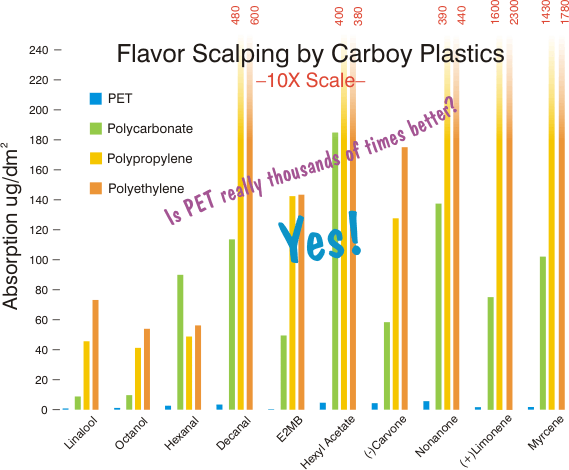| Introduction |
|
 |
|
Limonene (orange)
Absorption by Plastics
µg/dm2
|
Anecdotal Data –
When the term flavor scalping was originated, it was used to describe the removal of flavors from packaged foods and beverages by their packaging, typically one-way (single use) containers. The overall flavor of a food or beverage will change, if packaging sucks away flavors, and the choice of packaging can make or break a product. In current use, flavor scalping is also used to describe the movement of flavors in the other direction, from packaging into foods and beverages. For good reasons, winemakers and brewers take pains to avoid placing their products in contact with materials that will adversely affect flavors. This concern is a major reason why winemakers and brewers have traditionally put up with all the drawbacks of glass containers. It is fair to say that until BetterBottle offered its line of special PET fermentation carboys, all plastic and rubber items were automatically assumed to be problematic. Some people still find it hard to believe that BetterBottle carboys and fittings can be so much better than carboys and fittings made of other plastics, and they ask for proof. Of course, the best proof is in the actual pudding. Anyone with a sensitive nose will be able to confirm that BetterBottle carboys have no odor when they are new or after fermenting a highly aromatic wine or beer and a brief wash. And the BetterBottle carboys are even more resistant to staining than glass carboys. However, BetterBottle carboys and fittings are products of modern science and there is plenty of emirical evidence to explain and confirm what is obvious to the casual observer.
Empirical Data –
Using modern scientific tools, ranging from chromatography to genetic engineering, flavor chemists have learned a great deal about how we taste and smell. Strictly speaking, a flavor is not a chemical or mixture of chemicals; it is what we sense when the chemical(s) interact with the taste and aroma receptors in our mouths and noses, and one person may perceive a flavor differently than another. Taste is a relatively course sense. There are only five major types of taste receptors, those that respond to bitter, sweet, sour, salty, and umami (the MSG taste). It is the interactions of aromatic (volatile) chemicals in foods with hundreds of different types of receptors in our noses that make up complex flavors and allow us to make subtle discriminations.
Certain chemicals are known as "character impact compounds", because low concentrations of these chemicals trigger flavors that are strongly associated with certain foods. The flavors of packaged and fast foods are often improved by adding mixtures of these chemicals. Soaking strips of different plastics in solutions of these chemicals and then, using chromatography to measure how much of each chemical was taken up by each of the plastics provides a scientific basis for ranking the extent to which the plastics scalp flavors. Using this technique, PET has been shown to be far superior to other plastics that are typically used to make carboys, fittings, stoppers, and tubing. |
| Specific Tests |
|
Dr. Remco van Willige selected ten flavor chemicals with varying solubility, volatility, polarity, etc. to study the extent of uptake by four types of plastic, linear low density polyethylene (LLDPE), polypropylene (PP), polycarbonate (PC), and PET. 1
|
|

– (-)Carvone –
(spearmint) |

– Linalool –
(sweet, floral, alcoholic note) |

– Myrcene –
(core of many flavors) |

– (+)Limonene –
(orange) |
CH3(CH2)8CHO
– Decanal – |
CH3(CH2)4CHO
– Hexanal –
(Green aroma) |
CH3(CH2)5OC(=O)CH3
– Hexyl Acetate –
(fruity flavor) |
H(CH2)8OH
– Octanol –
(enhancer) |
CH3CH2OC(=O)CH(–CH3)CH2CH3
– E2MB –
(apple) |
CH3(CH2)7C(=O)CH3
– Nonanone –
(blue cheese/cooked butter) |
|
|
Dr. van Willige dissolved 100 µg of each of the flavor chemicals in a liter of surfactant (Tween 80) at pH = 4.2 ± 0.2 and soaked strips of the four plastics in the solutions for varying periods of time at a constant temperature of 20°C. The strips of polycarbonate were 75 µm thick, the strips of PET and polyethylene were 50 µm thick, and the strips of polypropylene were 30 µm thick. The PP and LLDPE films saturated within 14 days, but it was necessary to soak the PET and PC films for 28 days before they became saturated. The absorbed chemicals were measured by extracting them from the films with a known volume of organic solvent and measuring their concentration in the solvent by gas chromatography. The following two charts are summaries of a portion of Dr. van Willige's data. Compared with the other plastics, PET is in a class by itself.
|
|

|
|
It is necessary to amplify the scale by 10 times so the trace amounts of chemicals absorbed by PET show at all and then, many of the columns for the other plastics are completely off scale.
|
|

|
|
1 van Willige, R (2002) Effects of flavour absoprtion on foods and their packaging materials, Ph.D. Thesis, Wageningen University, The Netherlands
|
|